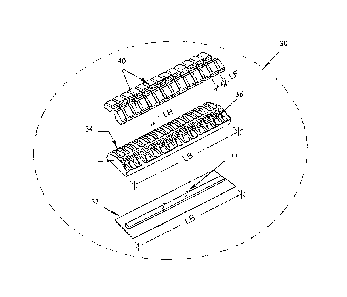Une partie des informations de ce site Web a été fournie par des sources externes. Le gouvernement du Canada n'assume aucune responsabilité concernant la précision, l'actualité ou la fiabilité des informations fournies par les sources externes. Les utilisateurs qui désirent employer cette information devraient consulter directement la source des informations. Le contenu fourni par les sources externes n'est pas assujetti aux exigences sur les langues officielles, la protection des renseignements personnels et l'accessibilité.
L'apparition de différences dans le texte et l'image des Revendications et de l'Abrégé dépend du moment auquel le document est publié. Les textes des Revendications et de l'Abrégé sont affichés :
| (12) Brevet: | (11) CA 2595002 |
|---|---|
| (54) Titre français: | ASSEMBLAGE DE DOUBLURE DE MOULIN |
| (54) Titre anglais: | MILL LINER ASSEMBLY |
| Statut: | Accordé et délivré |
| (51) Classification internationale des brevets (CIB): |
|
|---|---|
| (72) Inventeurs : |
|
| (73) Titulaires : |
|
| (71) Demandeurs : |
|
| (74) Agent: | MOFFAT & CO. |
| (74) Co-agent: | |
| (45) Délivré: | 2014-12-30 |
| (86) Date de dépôt PCT: | 2006-01-16 |
| (87) Mise à la disponibilité du public: | 2006-07-27 |
| Requête d'examen: | 2010-11-01 |
| Licence disponible: | S.O. |
| Cédé au domaine public: | S.O. |
| (25) Langue des documents déposés: | Anglais |
| Traité de coopération en matière de brevets (PCT): | Oui |
|---|---|
| (86) Numéro de la demande PCT: | PCT/AU2006/000049 |
| (87) Numéro de publication internationale PCT: | AU2006000049 |
| (85) Entrée nationale: | 2007-07-16 |
| (30) Données de priorité de la demande: | ||||||
|---|---|---|---|---|---|---|
|
Assemblage de doublure pour une utilisation dans un broyeur, l~assemblage de doublure comprenant un corps de doublure comprenant un élément de montage, et un élément amortisseur élastomérique connecté de manière opérationnelle à l~élément de montage. L~élément amortisseur comprend une pluralité de cavités de soutien dans celui-ci et une pluralité d~éléments d~usure montée dans les cavités de soutien.
A liner assembly for use in a grinding mill, the liner assembly including a
liner body including
a mounting member, and an elastomeric cushioning member operatively connected
to the
mounting member. The cushioning member includes a plurality of support
cavities therein,
and a plurality of wear elements mounted within the support cavities.
Note : Les revendications sont présentées dans la langue officielle dans laquelle elles ont été soumises.
Note : Les descriptions sont présentées dans la langue officielle dans laquelle elles ont été soumises.

2024-08-01 : Dans le cadre de la transition vers les Brevets de nouvelle génération (BNG), la base de données sur les brevets canadiens (BDBC) contient désormais un Historique d'événement plus détaillé, qui reproduit le Journal des événements de notre nouvelle solution interne.
Veuillez noter que les événements débutant par « Inactive : » se réfèrent à des événements qui ne sont plus utilisés dans notre nouvelle solution interne.
Pour une meilleure compréhension de l'état de la demande ou brevet qui figure sur cette page, la rubrique Mise en garde , et les descriptions de Brevet , Historique d'événement , Taxes périodiques et Historique des paiements devraient être consultées.
| Description | Date |
|---|---|
| Lettre envoyée | 2024-01-16 |
| Représentant commun nommé | 2019-10-30 |
| Représentant commun nommé | 2019-10-30 |
| Requête visant le maintien en état reçue | 2015-01-06 |
| Accordé par délivrance | 2014-12-30 |
| Inactive : Page couverture publiée | 2014-12-29 |
| Inactive : Taxe finale reçue | 2014-10-14 |
| Préoctroi | 2014-10-14 |
| Demande de correction du demandeur reçue | 2014-10-10 |
| Un avis d'acceptation est envoyé | 2014-04-14 |
| Lettre envoyée | 2014-04-14 |
| Un avis d'acceptation est envoyé | 2014-04-14 |
| Requête visant le maintien en état reçue | 2014-01-06 |
| Inactive : Lettre officielle | 2013-02-01 |
| Inactive : Approuvée aux fins d'acceptation (AFA) | 2013-01-30 |
| Requête visant le maintien en état reçue | 2013-01-04 |
| Demande de correction du demandeur reçue | 2012-09-04 |
| Modification reçue - modification volontaire | 2012-08-31 |
| Inactive : Dem. de l'examinateur par.30(2) Règles | 2012-03-01 |
| Demande de correction du demandeur reçue | 2011-09-12 |
| Lettre envoyée | 2010-11-10 |
| Requête d'examen reçue | 2010-11-01 |
| Exigences pour une requête d'examen - jugée conforme | 2010-11-01 |
| Toutes les exigences pour l'examen - jugée conforme | 2010-11-01 |
| Lettre envoyée | 2007-12-04 |
| Inactive : Déclaration des droits - Formalités | 2007-10-15 |
| Inactive : Transfert individuel | 2007-10-15 |
| Inactive : Notice - Entrée phase nat. - Pas de RE | 2007-10-10 |
| Inactive : Page couverture publiée | 2007-10-03 |
| Inactive : Notice - Entrée phase nat. - Pas de RE | 2007-10-01 |
| Inactive : CIB en 1re position | 2007-08-24 |
| Demande reçue - PCT | 2007-08-23 |
| Exigences pour l'entrée dans la phase nationale - jugée conforme | 2007-07-16 |
| Demande publiée (accessible au public) | 2006-07-27 |
Il n'y a pas d'historique d'abandonnement
Le dernier paiement a été reçu le 2014-01-06
Avis : Si le paiement en totalité n'a pas été reçu au plus tard à la date indiquée, une taxe supplémentaire peut être imposée, soit une des taxes suivantes :
Les taxes sur les brevets sont ajustées au 1er janvier de chaque année. Les montants ci-dessus sont les montants actuels s'ils sont reçus au plus tard le 31 décembre de l'année en cours.
Veuillez vous référer à la page web des
taxes sur les brevets
de l'OPIC pour voir tous les montants actuels des taxes.
Les titulaires actuels et antérieures au dossier sont affichés en ordre alphabétique.
| Titulaires actuels au dossier |
|---|
| VULCO S.A. |
| Titulaires antérieures au dossier |
|---|
| RICARDO ABARCA MELO |
| RICARDO FERNANDEZ DABERTI |